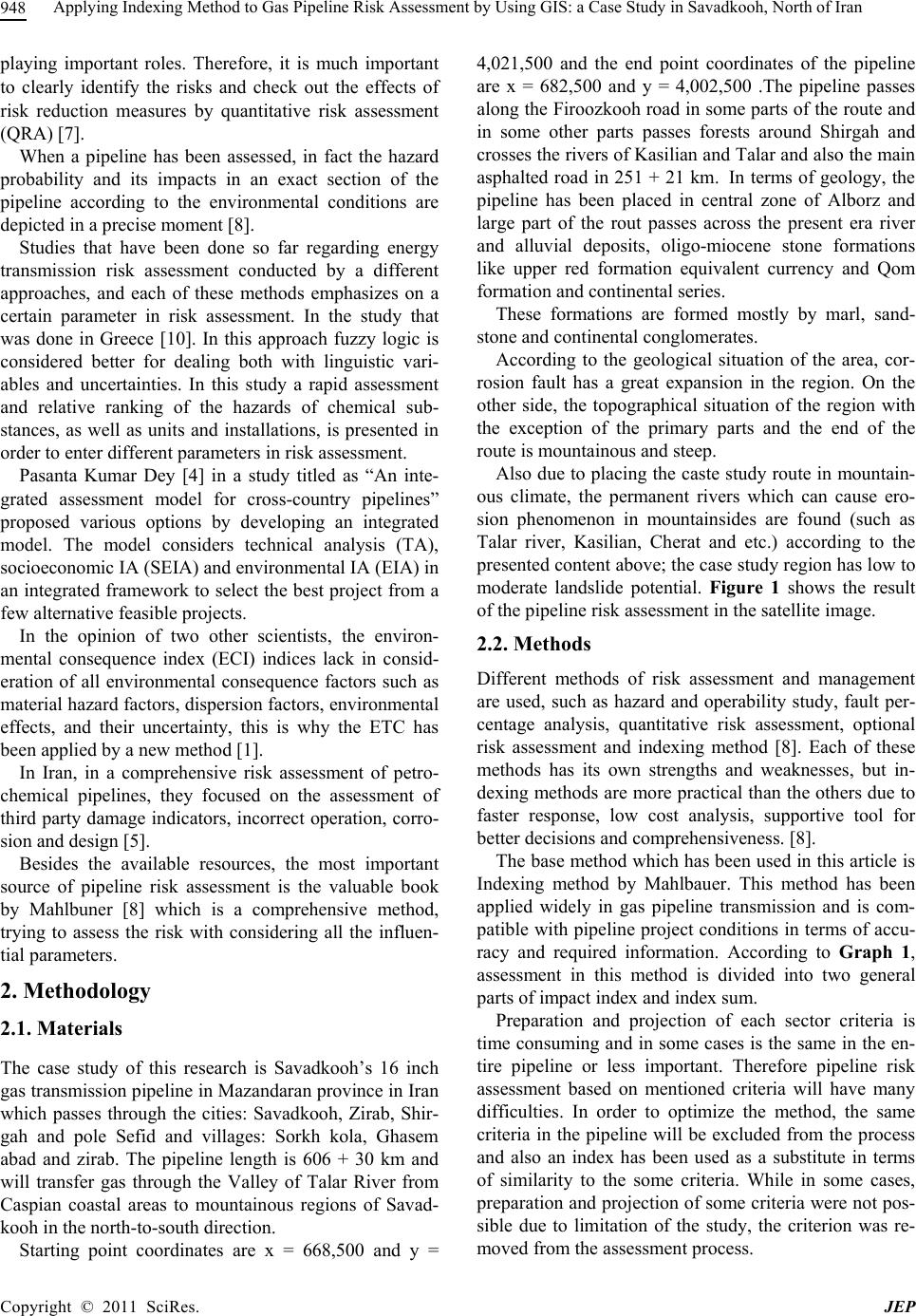
Applying Indexing Method to Gas Pipeline Risk Assessment by Using GIS: a Case Study in Savadkooh, North of Iran
948
playing important roles. Therefore, it is much important
to clearly identify the risks and check out the effects of
risk reduction measures by quantitative risk assessment
(QRA) [7].
When a pipeline has been assessed, in fact the hazard
probability and its impacts in an exact section of the
pipeline according to the environmental conditions are
depicted in a precise moment [8].
Studies that have been done so far regarding energy
transmission risk assessment conducted by a different
approaches, and each of these methods emphasizes on a
certain parameter in risk assessment. In the study that
was done in Greece [10]. In this approach fuzzy logic is
considered better for dealing both with linguistic vari-
ables and uncertainties. In this study a rapid assessment
and relative ranking of the hazards of chemical sub-
stances, as well as units and installations, is presented in
order to enter different parameters in risk assessment.
Pasanta Kumar Dey [4] in a study titled as “An inte-
grated assessment model for cross-country pipelines”
proposed various options by developing an integrated
model. The model considers technical analysis (TA),
socioeconomic IA (SEIA) and environmental IA (EIA) in
an integrated framework to select the best project from a
few alternative feasible projects.
In the opinion of two other scientists, the environ-
mental consequence index (ECI) indices lack in consid-
eration of all environmental consequence factors such as
material hazard factors, dispersion factors, environmental
effects, and their uncertainty, this is why the ETC has
been applied by a new method [1].
In Iran, in a comprehensive risk assessment of petro-
chemical pipelines, they focused on the assessment of
third party damage indicators, incorrect operation, corro-
sion and design [5].
Besides the available resources, the most important
source of pipeline risk assessment is the valuable book
by Mahlbuner [8] which is a comprehensive method,
trying to assess the risk with considering all the influen-
tial parameters.
2. Methodology
2.1. Materials
The case study of this research is Savadkooh’s 16 inch
gas transmission pipeline in Mazandaran province in Iran
which passes through the cities: Savadkooh, Zirab, Shir-
gah and pole Sefid and villages: Sorkh kola, Ghasem
abad and zirab. The pipeline length is 606 + 30 km and
will transfer gas through the Valley of Talar River from
Caspian coastal areas to mountainous regions of Savad-
kooh in the north-to-south direction.
Starting point coordinates are x = 668,500 and y =
4,021,500 and the end point coordinates of the pipeline
are x = 682,500 and y = 4,002,500 .The pipeline passes
along the Firoozkooh road in some parts of the route and
in some other parts passes forests around Shirgah and
crosses the rivers of Kasilian and Talar and also the main
asphalted road in 251 + 21 km. In terms of geology, the
pipeline has been placed in central zone of Alborz and
large part of the rout passes across the present era river
and alluvial deposits, oligo-miocene stone formations
like upper red formation equivalent currency and Qom
formation and continen tal series.
These formations are formed mostly by marl, sand-
stone and continen tal conglomerates.
According to the geological situation of the area, cor-
rosion fault has a great expansion in the region. On the
other side, the topographical situation of the region with
the exception of the primary parts and the end of the
route is mountainous and steep.
Also due to placing the caste study route in mountain-
ous climate, the permanent rivers which can cause ero-
sion phenomenon in mountainsides are found (such as
Talar river, Kasilian, Cherat and etc.) according to the
presented content above; the case study region has low to
moderate landslide potential. Figure 1 shows the result
of the pipeline risk assessment in the satellite image.
2.2. Methods
Different methods of risk assessment and management
are used, such as hazard and operability study, fault per-
centage analysis, quantitative risk assessment, optional
risk assessment and indexing method [8]. Each of these
methods has its own strengths and weaknesses, but in-
dexing methods are more practical than the others due to
faster response, low cost analysis, supportive tool for
better decisions and comprehensiveness. [8].
The base method which has been used in this article is
Indexing method by Mahlbauer. This method has been
applied widely in gas pipeline transmission and is com-
patible with pipeline project conditions in terms of accu-
racy and required information. According to Graph 1,
assessment in this method is divided into two general
parts of impact index and index sum.
Preparation and projection of each sector criteria is
time consuming and in some cases is the same in the en-
tire pipeline or less important. Therefore pipeline risk
assessment based on mentioned criteria will have many
difficulties. In order to optimize the method, the same
criteria in the pipeline will be excluded from the process
and also an index has been used as a substitute in terms
of similarity to the some criteria. While in some cases,
preparation and projection of some criteria were not pos-
sible due to limitation of the study, the criterion was re-
moved from the assessment process.
Copyright © 2011 SciRes. JEP